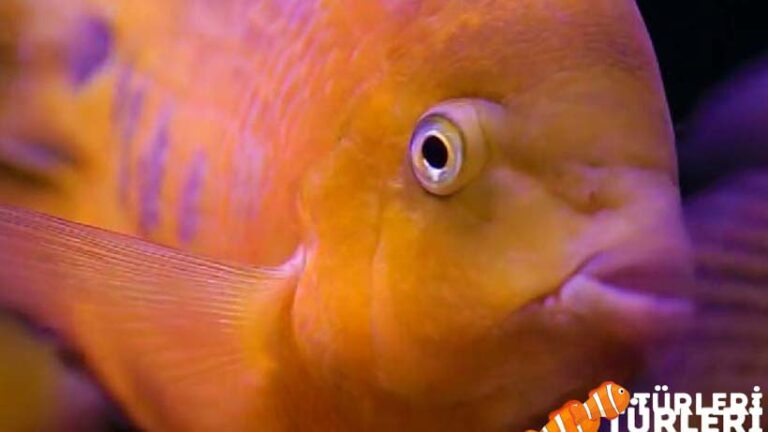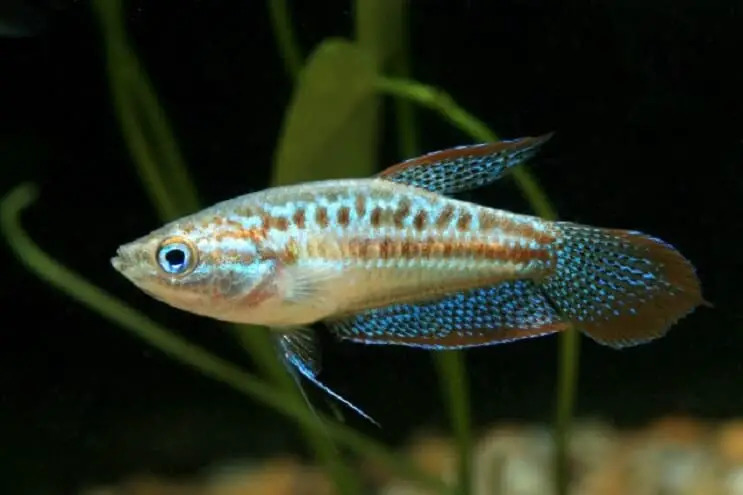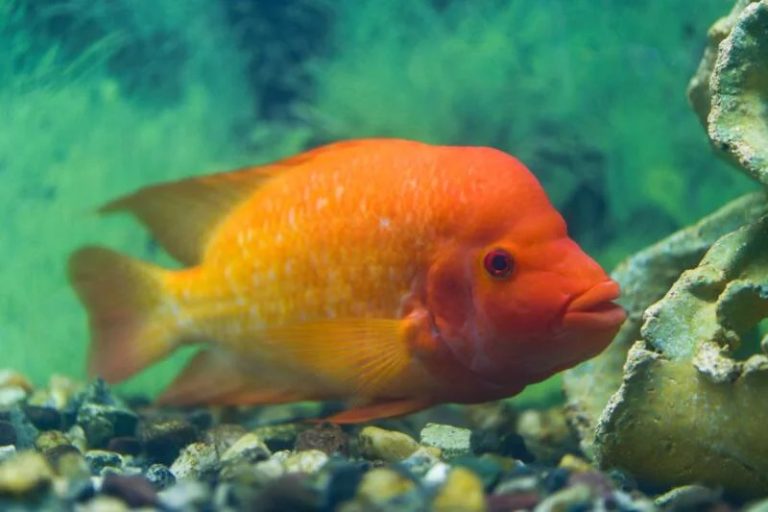What is Midas Cichlid? midas cichlid guide
Midas fish is a moderately difficult freshwater species to care for, which can reach quite large sizes. In this article, we will talk in detail about all the features of the Midas cichlid.
Midas Cichlid Species Summary
| Scientific Name: | Amphilophus citrinellus |
| Origin: | Central America (Nicaragua and Costa Rica) |
| Diet: | Omnivore |
| Behavior: | Highly aggressive |
| Behavior towards its own species: | Highly aggressive |
| Swimming Area: | All areas |
| Water Temperature: | 21 – 27 °C |
| Water Hardness: | 8 – 20 GH |
| pH Level: | 6.5 – 7.5 |
| Minimum Aquarium Size: | 200 liters |
| Adult Size: | 35 cm |
| Reproduction: | They lay eggs |
| Life Span: | 10 – 12 years |
| Care: | Moderately difficult |
Characteristics:
Midas cichlids are aggressive and combative fish, similar to betta fish. They generally display their aggressive behavior for the purpose of defending their territory or protecting their young. If necessary, they can fight persistently, like a relentless fighter, until the end.

They can reach up to 35 cm in length, but they usually grow to an average size of around 30 cm. They have a thick body and pointed fins. As they reach adult sizes, a hump begins to develop on their heads (nape area).
In their natural habitat, this hump only develops during the breeding season, but it remains in those bred in aquariums. Even though they have predominantly brown and black colors in their natural environments, in the aquarium setting, they appear in lighter shades, including white and orange.
Natural Habitat
The Midas cichlid, found in Central America, predominantly lives in the clear lakes of Costa Rica and Nicaragua. They prefer calm and slowly flowing warm waters.
They largely reside in areas abundant with rocks and tree roots.
Sexual Dimorphism
Distinguishing between male and female Midas is not difficult. By looking at a few points, you can easily understand the difference between males and females.
- Male Midas fish are larger than females.
- The hump at the back of the male Midas cichlid’s head is more pronounced and larger than that of the female.
- The dorsal and ventral fins of females are smaller than those of males.
- The genital protrusion in males appears more pointed and elongated.

Care
They require moderate care. Due to their aggressive nature and medium-level needs, they are recommended for those with intermediate knowledge rather than beginners.
Aquarium Size and Water Parameters
Midas cichlids require large aquariums. If you want to keep a single female, the volume should be at least 200 liters; for a single male, it should be 250 liters or more.
If you want to keep two Midas cichlids, one male and one female, you will need an aquarium of at least 400 liters. If you wish to add other fish with them, you should increase the volume to around 500-600 liters.
The reason for needing such a large aquarium is that if other fish enter their territory, Midas cichlids can kill them.
Their water parameters and aquarium maintenance aren’t very demanding. They require an average pH of 7.0, gH between 8-20, and a water temperature between 21-27°C.
In addition, you should perform regular weekly water changes and consistent aquarium maintenance. Tanks with high nitrate and phosphate levels are not suitable for Midas cichlids.
Feeding and Diet
Midas cichlids are omnivores, meaning they can eat both meat and plants. Predominantly meat-based diets are best for their vivid coloration and physical health.
They aren’t very picky about food. They mostly prefer prepared flakes and fresh live food. You can feed them live shrimp, worms, crickets, bloodworms, and small fish.
How to Feed Midas Fish?
Instead of feeding them once a day, it’s more beneficial to feed them in small amounts 2-4 times daily. This method reduces constipation in fish and prevents the rapid pollution of the aquarium water.
To prevent the commonly seen “hole in the head” disease in cichlids, occasionally provide vegetables like cucumber and lettuce.
Which Fish Do They Live With?
Even if kept in a 500-liter aquarium, if you add the wrong fish, you may soon find that only the Midas cichlid remains.
Therefore, you shouldn’t add slow swimmers, small, aggressive fish with Midas cichlids. Some fish that can coexist with them include jack dempsey, leopard catfish, firemouth cichlid, umbee cichlid, parrot cichlid, and green terror.
Breeding Midas Cichlid
Breeding in aquarium conditions is easy. Females are ready to breed when they reach 15 cm, and males at 17 cm. It won’t be challenging to breed them if the proper conditions are provided.

Aquarium Setup for Breeding
In the breeding aquarium, you should create numerous cave-like structures using rocks and cubes. In addition, you can create extra spaces using pots made from natural materials.
During mating periods, male Midas cichlids can be very aggressive towards the female. To prevent harm, you can place a divider in the middle of the aquarium and make a hole in it. This hole should be large enough for the female to pass through but not the male, allowing the female to escape if necessary.
Note: It’s essential to secure the decorations in your aquarium properly, especially rocks. This is because Midas cichlids enjoy playing with decorations, and you should secure them well to prevent rocks from hitting the glass.
Breeding
When ready to breed, Midas cichlids will court each other by swimming around one another and touching tails. Females will rub the protrusion on their heads against the males’ sides.
These behaviors can take place over approximately 2 to 7 weeks. After this period, when they’re ready, mating will occur.
After mating, the female Midas will lay about 1000 eggs. The eggs will hatch within 2-5 days, and the Midas fry will begin free swimming. You can see the free-swimming fry in the picture above.
The fry will remain a pale-grey color until they reach about 7-8 cm. After reaching this size, they will start to color up quickly. To feed the fry, you can use the same food given to adults but crushed into smaller pieces.
Midas and Parrot Fish
Midas cichlids bear a strong resemblance to parrot cichlids. In fact, it’s challenging to find a purebred Midas because a significant percentage of the males are sterile.
The Midas fish in the wild has been artificially crossbred with the parrot fish, resulting in the Midas cichlids found in aquariums.
Diseases
Even though the Midas fish is resilient, it is susceptible to several diseases. The main causes of these diseases are water pollution and insufficient nutrition.
Most common diseases include:
White Spot (Ichthyophthirius multifiliis or Ich): Often seen in stressed fish. The cause of this disease is external parasites. For more information and treatment regarding this disease, refer to: What is White Spot disease?
Hole in the Head (HITH): This condition can arise due to inadequate nutrition, poor and polluted water conditions, and vitamin deficiency.
Fungal and Parasitic Diseases:
These fish are susceptible to internal parasite and fungal infections. For detailed information about these diseases, check: Fish diseases.
By meeting the needs of the fish, not neglecting aquarium maintenance, and paying attention to water parameters, your Midas fish will be with you for many years.
FAQs
Are Midas and Parrot Cichlid the Same Fish?
No, although the Midas fish and parrot cichlid may look very similar, they are not the same species. However, purebred Midas are very rare and are often bred with parrot cichlids.
Which Fish Can Midas Cichlid Coexist With?
Midas cichlid can coexist in the same aquarium with fish such as jack dempsey, Suckermouth catfish, firemouth cichlid, umbee cichlid, parrot cichlid, and green terror.
Kaynaklar: Wikipedia








